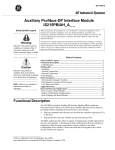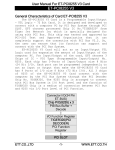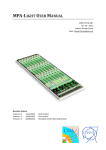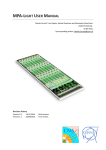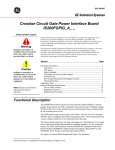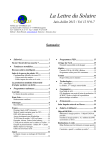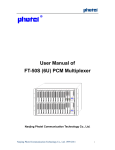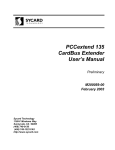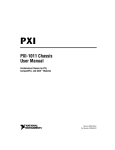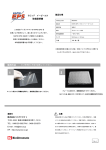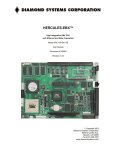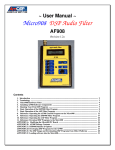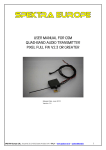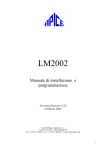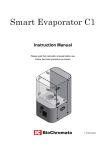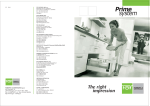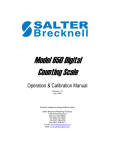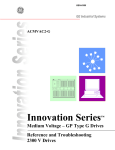Download GEI-100310, Bridge Interface Board IS200BICR
Transcript
g GEI-100310 GE Industrial Systems Bridge Interface Board IS200BICRH_A_ _ Safety Symbol Legend These instructions do not purport to cover all details or variations in equipment, nor to provide every possible contingency to be met during installation, operation, and maintenance. If further information is desired or if particular problems arise that are not covered sufficiently for the purchaser’s purpose, the matter should be referred to GE Industrial Systems. Indicates a procedure or condition that, if not strictly observed, could result in personal injury or death. This document contains proprietary information of General Electric Company, USA, and is furnished to its customer solely to assist that customer in the installation, testing, operation, and/or maintenance of the equipment described. This document shall not be reproduced in whole or in part, nor shall its contents be disclosed to any third party without the written approval of GE Industrial Systems. Section Indicates a procedure or condition that, if not strictly observed, could result in damage to or destruction of equipment. Note Indicates an essential or important procedure or statement. Page Functional Description ............................................................................................. 1 Line Voltage Feedback...................................................................................... 3 Motor Voltage Feedback ................................................................................... 4 Motor Current Feedback ................................................................................... 5 Fault Sring and MA/MB Contactor Control ...................................................... 7 Analog/Digital Converter Inputs ....................................................................... 8 Digital/Analog Converter Outputs..................................................................... 9 Discrete Digital Inputs..................................................................................... 10 Solid State Relay Digital Outputs.................................................................... 11 Application Data..................................................................................................... 11 Renewal/Warranty Replacement............................................................................. 15 How to Order a Board ..................................................................................... 15 Handling Precautions....................................................................................... 16 Replacement Procedures ................................................................................. 16 Functional Description The IS200BICR Bridge Interface Board (BICR) is used in Innovation Seriesä Medium Voltage - GP, Type H drives. It provides an interface between the bridge and the drive control. Analog feedback signals from the bridge are connected to TB1 and TB2 on the BICR board's faceplate. These signals are scaled and converted to voltage controlled oscillator (VCO) signals and then passed to the IS200DSPX Digital Signal Processor Control Board (DSPX). Basic bridge cell hardware control, protection, and diagnostics are implemented on the Medium Voltage Ac Drive FiberOptic Hub (FOHB) board. The FOHB board functions are interfaced to the control through the IS200BPIR Digital Interface Board (BPIR). The BPIR and BICR boards are mounted in an Innovation Series board rack and connect to the IS200CABP Cable Assembly Backplane Board (CABP) through their P1 connectors (also P2 connector for BICR board). The logic signals from the BPIR board are interfaced to the BICR board through the CABP board. Innovation Series is a trademark of General Electric Company, USA. The BICR board also provides a panel and system fault string interface, eight optically isolated discrete digital inputs and outputs, two 0-20 mA analog feedback inputs and one 0-10 V analog feedback input. Bridge control, fault string, isolated I/O, and the 0-20 mA connections are made through the P1 connector. The main control board interface and logic power supply connections are made through the P2 connector (see Figure 1 and Table 1). A serial 1024-bit memory device is provided on the BPIR board. This memory is programmed with board identification and revision information and accessed through a single data line (BRDID) on the P1 connector. A B C Line Voltage Feedback VCO1 LVAB VCO6 LVBC A B C Motor Voltage Feedback VCO4 MVAB VCO5 MVBC TB1 P2 V Neutral B TB2 IOC A,B &C P1 P2 IOC Trip V Ref A A/D D/A Ref B 0-20 mA B P1 Ref C XBUS Add, Data & Control P1 ISO DIG Ins P2 Clock Watchdog Logic P2 VCO3 MIC TEMP 0-20 mA A P1 VCO2 MIB Motor Current Feedback C EPLD Spare BPIR Connections ISO DIG 8 Outs P! Contactor EStop Logic P1 PLO BPIR I/O Connections P1 Figure 1. BICR Board Block Diagram Table 1. BICR Board Typical Power Requirements Voltage Current +05 V dc 300 mA +15 V dc 150 mA -15 V dc 150 mA +24 V dc (Isolated) 2 · IS200BICR Board 50 mA GEI-100310 Line Voltage Feedback BICR board voltage to frequency gain errors are less than ±1.7%. Two line-to-line ac input voltages (LVA-B and LVB-C) are derived by resistive attenuated monitoring of the three input phases. Attenuation strings are connected to TB1 and the string resistance (Rx) is varied to scale the feedback (see Figure 2). The two voltages are converted to VCO signals and passed through the P2 connector to VCO counters on the DSPX board. The VCO is biased so that with 0 V input, the output frequency is 1 MHz. Full scale is ±1 MHz from the 0 V bias frequency. Output frequency per peak (pk) input volt can be obtained using the following formula: (also see Table 2) Hz/Vpk = 2.37 K * 168492 Hz / ( Rx + .0095 M) LVA-B TB1-2 LVB LVAB - VCO + P2-A26 VCO1 LVB-C LVA - TB1-1 + LVC + TB1-3 - LVBC VCO P2-B27 VCO6 LVA-C Figure 2. BICR Board Line Voltage Feedback Diagram Table 2. BICR Board Line Voltage Outputs (per Input Rx) RMS L-L Voltage GEI-100310 Input Rx Value Pk L-L Voltage LVFBK VCO Hz/V FS LVFBK L-L Pk Voltage LVAB LVBC TP @ RMS L-L 2400 1800000 3394.1 220.683 4400.8 3.143 3000 2200000 4242.6 180.731 5422.4 3.218 3300 2400000 4666.9 165.730 5913.2 3.246 4160 3000000 5883.1 132.688 7385.7 3.276 4800 3500000 6788.2 113.784 8612.8 3.241 6000 4200000 8485.3 94.863 10330.7 3.378 6600 4800000 9333.8 83.029 11803.1 3.252 6900 5000000 9758.1 79.714 12294.0 3.264 7200 5200000 10182.3 76.653 12784.9 3.276 8400 6000000 11879.4 66.449 14748.2 3.313 10000 7200000 14142.1 55.389 17693.0 3.287 11000 7900000 15556.3 50.487 19410.9 3.296 12000 8600000 16970.6 46.382 21128.9 3.303 12500 9500000 18667.6 41.992 23337.8 3.290 13800 10000000 19516.1 39.895 24564.5 3.267 IS200BICR Board · 3 Motor Voltage Feedback BICR board voltage to frequency gain errors are less than ± 1.9%. Two line-to-line motor output voltages (MVA-B and MVB-C) are derived by resistive attenuated monitoring of the three output phases. Attenuation strings are connected to TB2 and the string resistance Rx is varied to scale the feedback. The two voltages are converted to VCO signals and passed through the P2 connector to VCO counters on the DSPX board (see Figure 3). The VCO is biased so that with 0 V input, the output frequency is 1.02 MHz. Full scale is ±1 MHz from the 0 V bias frequency. Output frequency per pk output volt can be obtained using the following formula: (also see Table 3) Hz/Vpk = 5 K * 80172.6 Hz / ( Rx + .005 M) The motor output neutral voltage (VN) is also monitored. This voltage is scaled and then passed to one of the 10-bit A/D converters that has a ±1 V full scale input (1/2 VN). The VN is scaled through the attenuation strings and the ± full-scale neutral pk voltage can be obtained using the following formula: ±V pk full scale = 2 V * (Rx + .005 M)/ 5 K -VAN MA TB1-5 + -VBN MB TB1-6 MC VCO + VCO P2-D26 VCO4 + -VCN TB1-7 MVAB + MVBC P2-A27 VCO5 + VN + + + To A/D Converter 2 V Ref Figure 3. BICR Board Motor Voltage Feedback Diagram 4 · IS200BICR Board GEI-100310 Table 3. BICR Board Motor Voltage Outputs (per Input Rx) RMS L-L Voltage Input Rx Value Pk L-L Voltage MVFBK VCO Hz/V FS MVFBK LL Pk Voltage MVAB MVBC TP @ RMS L-L 2400 1800000 3394.1 222.640 4401.7 3.163 3000 2200000 4242.6 182.169 5379.6 3.237 3300 2400000 4666.9 166.991 5868.6 3.264 4160 3000000 5883.1 133.599 7335.4 3.294 4800 3500000 6788.2 114.516 8557.8 3.258 6000 4200000 8485.3 95.432 10269.1 3.395 6600 4800000 9333.8 83.504 11736.0 3.268 6900 5000000 9758.1 80.165 12224.8 3.280 7200 5200000 10182.3 77.082 12713.7 3.291 8400 6000000 11879.4 66.805 14669.6 3.328 10000 7200000 14142.1 55.672 17603.1 3.302 11000 7900000 15556.3 50.739 19314.5 3.311 12000 8600000 16970.6 46.609 21026.0 3.318 12500 9000000 17677.7 44.538 22003.7 3.302 13200 9500000 18667.6 42.194 23226.1 3.304 13800 10000000 19516.1 40.084 24448.7 3.282 Motor Current Feedback The two motor output current voltage signals, IB and IC, are derived by monitoring the B and C output phase currents using open or closed loop hall effect or LEM™ sensors connected to TB1 and TB2 (see Figure 4). The front end sensor differential amplifier circuits can be configured for multiple inputs and gains of unity (0.5 and 0.25) through various sensor connection schemes to TB1 and TB2. In high current applications requiring two sensors per phase, the sensors should be connected as shown in the parallel sensor connection diagram (see Figure 5). Note External burden resistors are required when using closed loop sensors. The burden resistor value should be selected to produce ± 10 V across the burden resistor with ± full scale sensor output current. IB and IC voltages are converted to VCO signals (MIB and MIC) and passed through the P2 connector to the DSPX board VCO counters. The VCO is biased, so that with 0 V at IB and IC the output frequency is 1 MHz. Full scale is ± 1 MHz from the 0 V bias frequency and is produced with a ± 5 V pk at IB or IC. BICR board voltage-tofrequency gain errors are less than ± 1.7%. Peak full scale is also represented as ± 5 V at the MIA, MIB, and MIC test points. IA voltage is derived from the inverted sum of IB and IC. All three voltages are passed to window compare circuits to detect for an instantaneous overcurrent (IOC) condition. The IOC trip thresholds are programmed from one of the outputs of the D/A converter. Zero to + full scale of the D/A output corresponds to zero full scale of the sensor current. GEI-100310 IS200BICR Board · 5 +15 TB1-9 TB1-10 VCO B MIB TB1-12 MIB -15 P2-B26 VCO2 +15 MIB TB2-1 -15 TB2-2 IB -IB FBK IOCB Filter Window Compare IOCA Filter Window Compare IOCC IA + TB2-3 Filter Window Compare TB2-4 + To EPLD MIB TB1-11 MIB TB2-5 C MIB TB2-6 +15 IC MIB TB2-7 -15 TB2-8 IOC Ref -IC FBK TB2-9 MIC + VCO P2-C26 VCO3 TB2-10 TB2-11 TB2-12 Figure 4. BICR Board Motor Current Feedback Diagram TB1-4 TB1-5 TB1-6 -IB FBK1 Out GND TB1-7 SHLD IB1P ± 10 V TB1-8 IB2P IB1N Note: Current is Negative TB1-9 IB2N TB1-10 IB3N TB1-11 TB1-12 TB2-1 -IB FBK 20 K IB3P 40 K 10 K 40 K - IB ± 5V + 40 K 40 K 20 K +15 10 K -15 GND Typical single sensor connections. Phase B TB1-4 TB1-5 Out GND Out GND SHLD IB3P -IB FBK1 TB1-6 ± 10 V TB1-7 IB2P -IB FBK2 ± 10 V TB1-8 IB1N TB1-9 IB2N Note: Current is Negative IB1P TB1-10 IB3N TB1-11 TB1-12 TB2-1 +15 -IB FBK 20 K 40 K 10 K 40 K + IB ±5V 40 K 40 K 20 K 10 K -15 GND Typical Dual Sensor Connections. Phase B Figure 5. Motor Current Feedback Sensor Connection Diagram 6 · IS200BICR Board GEI-100310 Fault String and MA/MB Contactor Control There are two fault sting inputs to the BICR board: (see Figure 6) · One input dedicated to the panel series string of interlock contacts · One input dedicated to the system string of interlock contacts The input terminals for these fault strings are 24 V, 115 V, and common and each fault string is fuse protected. Typical connections are between the common and one of the voltage terminals. The inputs are isolated so one string can be operated at 24 V while the other is operated at 115 V. Loading of the inputs is 20 mA maximum. One of the specified voltages must be applied to both inputs for normal operation. Current ratings for the MA and MB contactors are as follows: · MA Form C: 6 A @ 125 V ac .6 A @ 110 V dc 2 A @ 30 V dc · MB Form A: .6 A @ 125 V ac .6 A @ 110 V dc 2 A @ 30 V dc The states of the inputs are reported back to the DSPX board. Both inputs are hardware ANDed to provide a master enable for the MA and MB contactor pilot relays. Dropping out either or both of these inputs while the drive is running will sequence a controlled shutdown. The MA contactor pilot relay has two functions: · Providing a set of Form C contacts to control the main contactor · Control of the bridge RUN signal to the FOHB board through the HR1/HR2 contact To pick up this relay, the C Disable and NMAC lines must be low, and the fault string must be satisfied. An MA sense input is provided and should be used with an interlock on the MA contactor to inhibit bridge firing if the main contactor does not pick up. To pick up the MB relay, the C Disable and NMBC lines must be low and the fault string satisfied. Both the MA and MB pilot relays are dropped out on a WD fault. Note Sense input for the MA contactor is 24 - 115 V ac/dc with a loading of 4 - 10 mA peak. No dedicated sense input is provided for the MB contactor. The hardware configuration assures that if a fault string is broken while the drive is running, bridge firing will be disabled before the MA or MB contactors drop out. Sequencing of the contactors and the FOHB board RUN signal is done in software using the NMAC, NMBC, RUN, and BICDABL control outputs and the MASEN, LOCFLT, SYSFLT, and bridge feedback fault lines. The BICDABL line is asserted high during power-up or hard reset configuration of the BICR board's electronically programmable logic device (EPLD). Taking this line high assures the MA and MB contactors do not pick up until commanded. A watchdog circuit in the EPLD monitors the 20 MHz (clk0) and 16 MHz (clk16) clock signals. If the 20 MHz or 16 MHz clock is not present, bridge firing will be disabled, and the MA and MB contactors and discrete digital outputs will drop out. If a clock failure occurs while the bridge is firing, the RUN signal will also be removed. In addition to the clk0 and clk16 watchdog, two additional watchdogs are implemented in the EPLD. If bridge firing power is enabled through the power electronics enable bit, the watchdog toggle bit must be written to an alternate state within a clkt1 period. The clkt1 period must be less than 20,000 clk0 periods, or a watchdog fault will be generated. GEI-100310 IS200BICR Board · 7 P1-B2 MASENP P1-B4 MASENN 24-115 V Buffer EPLD MASEN DRVP5 EPLD P5 MACOM NMAC P1-C21 P1-A5 MAC MANC BIC_DABL P5 P5 EPLD MANO P1-A3 P1-A1 MBCOM P1-A7 NMBC MBC MBNO P1-B6 P1-B8 PNF115 PNF24 P1-A9 EPLD LOCFLT (PNF) Local Fault String P1-D2 LKCOM P1-C1 P1-C3 LNF115 P5 EPLD LNF24 SYSFLT (LNF) System Fault String P1-C5 LNFCOM P5 Figure 6. Fault String and MA/MB Contactor Control Block Diagram Analog/Digital Converter Inputs There are four analog/digital (A/D) converter input channels as shown in Table 5 and Figure 7. Channel one of the A/D converter monitors the motor neutral voltage (VN). VN is a bipolar voltage that is biased at 1 V for a neutral voltage of 0 V. Full scale voltage for this input into the A/D converter is ±1 V. Channel two of the A/D converter monitors a temperature signal sent from the FOHB board and represents the peak temperature of the cells during normal operation. Full scale at the input terminals (P1-TEMP and P1-TEMPC) is 10 V. This voltage is used for temperature fault indication as shown in Table 4. Table 4. Temperature Fault Inputs 8 · IS200BICR Board Voltage Indication 10 V - 8 V OK 8V-2V Over Temp Warning 2V-0V Over Temp Trip GEI-100310 Channels three and four are externally multiplexed to provide two additional analog inputs. The auxan line is used to select the two additional inputs. With an auxan logic low, channels three and four are assigned to the 0-20 mA input circuits. There are two 0-20 mA inputs that are scaled for zero to full scale on two of the A/D converter outputs. Channels three and four are assigned to the 0-10 V and board temperature circuit outputs when the auxan line is asserted high. 2 V Ref From VN P1-C30 Ch1 TEMPC - TMP + P1-C32 Ch2 NACS ACLK2 8 MHz TEMP AD7777 D0 - D9 NWR P1-D7 P1-D8 P1-D9 P1-D10 AP AN 0-20 mA Ch3 BP BN 0-20 mA Ch4 From EPLD I/O XBUS NRD Figure 7. A/D Converter Interface Table 5. Analog/Digital Converter Input Specifications Input Range VN Neutral ±2V A/D Chnl. Auxan Bit A/D Count Tolerance 1 NA 256 Cnt./V ± 2.5% NA 102.4 Cnt./V ± 2.5% 0 - 10 V 2 mA Input - B 0 - 20 mA 3 0 48.9 Cnt./mA ± 3.5% V Input - C 0 - 10 V 3 1 99.9 Cnt./V ± 3.5% mA Input - A 0 - 20 mA 4 0 48.9 Cnt./mA ± 3.5% Board Temp 0 - 5 V @ RTD 4 1 204.8 Cnt./V ± 5.0% Cell Temp Digital/Analog Converter Outputs There are four 12-bit digital/analog (D/A) converters on the BICR board (see Figure 8). Three of these outputs are scaled and buffered to provide the bipolar phase reference required by the bridge PWM modulator located on the FOHB board. The forth converter is set between 0 to + full scale to set the motor IOC trip reference level. All four converter data registers are double buffered. The R/W data register are loaded, and the new values transferred to the analog outputs, at the same time as the /LD line is asserted low. All registers are set to the midpoint (0 V) when the DARST line is set high. GEI-100310 IS200BICR Board · 9 ± 10 V REF A PLO-43 Ref P10 DADCS XBUS Ctl DARST NDALD /CS A0 A1 R/W /RST /LD D11 ± 10 V Ref H P5 + + O1 REF B PLO-50 O2 ADC8412 XBUS Data Ref L O3 D0 ± 10 V + O4 REF C PLO-47 Ref N10 ± 10 V + + IOCREFN IOCREFP Figure 8. Reference D/A Converter Interface Block Diagram Discrete Digital Inputs There are eight differential discrete inputs routed to the BICR board from the CTBC terminal board through the CABP board. The sense of the inputs is such that a high input on the CTBC results in a high input to the BICR board's EPLD. The discrete inputs are optically coupled to the control logic. Each input has a yellow LED to indicate its state. Overvoltage protection up to 60 V is provided. Note Input voltages above 60 V cause the 7.5 V zener diode to sink to 30+ mA, causing it to dissipate more than its rated power (250 mW). The zener diode can handle non repetitive pulses of 10 W for 1 ms. Table 6. Discrete Input Specifications Specification Conditions Input Range 10 · IS200BICR Board Min / Typ / Max (Units) 0 to +30 V dc Loading Vin = +30 V dc Max = 20 mA Positive Threshold Vin Increasing Max = +20 V Negative Threshold Vin Decreasing Min = +5 V Hysteresis Min = 4.5 V Turn-On Time Typ = 3 µs Turn-Off Time Typ = 2.8 µs Rise Time Typ = 1.6 µs Fall Time Typ = 2.2 µs Isolation Voltage Min = 2500 V ac rms GEI-100310 Solid State Relay Digital Outputs There are eight solid state relay outputs routed from the BICR board to the CTBC terminal board through the CABP board. A high output from the BICR board's EPLD results in the output relay being closed and a low output from the EPLD results in the output relay being opened. The default relay output state is open (EPLD output pulled low). The relay outputs are optically isolated from the control. Each output has a yellow LED to indicate its state. Transient voltage suppression is provided to clamp the output voltage at 32 V. Note When clamping at 32 V, the zener diodes can withstand up to 30 mA of current before they exceed their power rating (500 mW). The zeners can handle nonrepetitive pulses of 10 W for 10 ms. Table 7. Solid State Relay Output Specifications Specification Conditions Min / Typ / Max (Units) Output Voltage Rating Max = 28 V dc Output Current Rating Max = 0.7 A dc Turn-On Time Photovoltaic Relay Typ = 2.0 ms Turn-Off Time Photovoltaic Relay Typ = 0.5 ms Isolation Voltage Min = 4000 V ac rms Application Data The BICR board includes two terminal boards, two backplane connectors, eight user testpoints, eighteen LED indicators, and two fuses. There are no adjustable hardware devices on the board. Refer to Figure 9 for component locations and the following tables for descriptions. Note There are additional testpoints and an additional connector (JTAG) on the BICR board surface. These are for development use only and not described in this publication. Table Description 8 TB1 Terminal Board 9 TB2 Terminal Board 10 User Testpoints 11 LED Indicators 12 Fuses Note Backplane connectors P1 and P2 require a custom extender board to access individual pin signals. Checking of these signals is not a part of standard in-service testing/troubleshooting procedures and these signals are not described in this publication. GEI-100310 IS200BICR Board · 11 FU2 FU1 DS1 DS10 DS11 DS12 DS13 DS14 DS15 DS16 DS17 DS9 DS2 DS3 DS4 DS5 DS6 LVA-B TP6 LVB-C TP7 MVA-B TP2 MVB-C TP1 COM TP21 MIA TP5 MIB TP3 MIC TP4 TP19 0MAC DS18 TP20 0MBC DS7 DS8 SW43 SW44 SW45 SW46 SW47 SW48 SW49 SW50 I24 TP14 TP15 I24_RTN TB1 TB1 Connector TP18 IMOK IS200BICRH1A DCOM TP10 CONF_DONE TP17 QSTATUS TP16 TP9 TB2 TB2 Connector P5 JTAG TP21 BIC_PSOK P15 TP11 N15 TP12 TP13 ACOM Figure 9. BICR Board Layout Diagram 12 · IS200BICR Board GEI-100310 Table 8. TB1 Bridge Feedback Terminal Board Pin Descriptions Pin Name Description 1 LVA Line Voltage resistive attenuation Phase A input 2 LVB Line voltage resistive attenuation Phase B input 3 LVC Line voltage resistive attenuation Phase C input 4 SHLD Shield Connection 5 IB3P Phase B current sensor A = .5 + input 3 6 IB1P Phase B current sensor A = .25 + input 1 7 IB2P Phase B current sensor A = .25 + input 2 8 IB1N Phase B current sensor A = .25 – input 1 9 IB2N Phase B current sensor A = .25 – input 2 10 IB3N Phase B current sensor A = .5 – input 2 11 P15 + 15 V Supply 13 N15 - 15 V Supply Table 9. TB2 Bridge Feedback Terminal Board Pin Descriptions GEI-100310 Pin Name Description 1 ACOM Analog ± 15 V Common 2 IC3P Phase C current sensor A = .5 + input 3 3 IC1P Phase C current sensor A = .25 + input 1 4 IC2P Phase C current sensor A = .25 + input 2 5 IC1N Phase C current sensor A = .25 – input 1 6 IC2N Phase C current sensor A = .25 – input 2 7 IC3N Phase C current sensor A = .5 – input 3 8 SHLD Shield Connection 9 MVA Motor voltage resistive attenuation Phase A input 10 MVB Motor voltage resistive attenuation Phase B input 11 MVC Motor voltage resistive attenuation Phase C input 12 SHLD Shield Connection to Chassis IS200BICR Board · 13 Table 10. User Testpoints* Testpoint Name Description TP6 LVA-B Line Phase Voltage A-B ±5.94 V pk FS TP7 LVB-C Line Phase Voltage B-C ±5.94 V pk FS TP2 MVA-B Motor Phase Voltage A-B ±5.94 V pk FS TP1 MVB-C Motor Phase Voltage B-C ±5.94 V pk FS TP21 COM Signal Common TP5 MIA Motor Phase A Current ±5 V pk FS TP3 MIB Motor Phase B Current ±5 V pk FS TP4 MIC Motor Phase C Current ±5 V pk FS *These user testpoints are accessible through the opening in the BICR board faceplate and are listed in the order (from top to bottom) that they are arranged on the board. Table 11. LED Indicators* LED Color Name Description DS1 Green IMOK ON when power applied and board functioning properly DS2 Yellow DO2 Digital relay number 2 output, ON when closed DS3 Yellow DO3 Digital relay number 3 output, ON when closed DS4 Yellow DO4 Digital relay number 4 output, ON when closed DS5 Yellow DO5 Digital relay number 5 output, ON when closed DS6 Yellow DO6 Digital relay number 6 output, ON when closed DS7 Yellow DO7 Digital relay number 7 output, ON when closed DS8 Yellow DO8 Digital relay number 8 output, ON when closed DS9 Yellow DO1 Digital relay number 1 output, ON when closed DS10 Yellow DI1 Discrete digital input number 1, ON when active DS11 Yellow DI2 Discrete digital input number 2, ON when active DS12 Yellow DI3 Discrete digital input number 3, ON when active DS13 Yellow DI4 Discrete digital input number 4, ON when active DS14 Yellow DI5 Discrete digital input number 5, ON when active DS15 Yellow DI6 Discrete digital input number 6, ON when active DS16 Yellow DI7 Discrete digital input number 7, ON when active DS17 Yellow DI8 Discrete digital input number 8, ON when active DS18 Yellow CONF_DONE ON when contactor control configuration complete *LEDs DS2 - DS18 that are visible through the faceplate opening are for troubleshooting purposes and do not need to be observed during normal operation. Table 12. Fuses Fuse 14 · IS200BICR Board Path Description and Part Number FU1 Local fault string 250 V, 200 mA; 44A725207-004 FU2 System fault string 250 V, 200 mA; 44A725207-004 GEI-100310 Renewal/Warranty Replacement How to Order a Board When ordering a replacement board for a GE drive, you need to know: · How to accurately identify the part · If the part is under warranty · How to place the order This information helps ensure that GE can process the order accurately and as soon as possible. Board Identification A printed wiring board is identified by an alphanumeric part (catalog) number located near its edge. Figure 10 explains the structure of the part number. The board’s functional acronym, shown in Figure 10, is normally based on the board description, or name. For example, the BICR board is described as the Bridge Interface board. IS 200 BICR H# A A A Artwork revision1 Functional revision1 Functional revision2 Group (variation, G or H) Functional acronym Assembly level3 Manufacturer (DS & IS for GE in Salem, VA) 1Backward compatible backward compatible 3 200 indicates a base-level board; 215 indicates a higher-level assembly or added components (such as PROM) 2Not Figure 10. Board Part Number Conventions Warranty Terms The GE Terms and Conditions brochure details product warranty information, including warranty period and parts and service coverage. The brochure is included with customer documentation. It may be obtained separately from the nearest GE Sales Office or authorized GE Sales Representative. GEI-100310 IS200BICR Board · 15 Placing the Order Parts still under warranty may be obtained directly from the factory: GE Industrial Systems Product Service Engineering 1501 Roanoke Blvd. Salem, VA 24153-6492 USA Phone: +1 540 387 7595 Fax: +1 540 387 8606 (“+” indicates the international access code required when calling from outside of the USA.) Renewals (spares or those not under warranty) should be ordered by contacting the nearest GE Sales or Service Office. Be sure to include the following when ordering any warranty or renewal parts: · Complete part number and description · Drive serial number · Drive Material List (ML) number Note All digits are important when ordering or replacing any board. The factory may substitute later versions of boards based on availability and design enhancements. However, GE Industrial Systems ensures backward compatibility of replacement boards. Handling Precautions To prevent component damage caused by static electricity, treat all boards with static sensitive handling techniques. Wear a wrist grounding strap when handling boards or components, but only after boards or components have been removed from potentially energized equipment and are at a normally grounded workstation. Printed wiring boards may contain static-sensitive components. Therefore, GE ships all replacement boards in antistatic bags. Use the following guidelines when handling boards: · Store boards in antistatic bags or boxes. · Use a grounding strap when handling boards or board components (per previous Caution criteria). Replacement Procedures To prevent electric shock, turn off power to the board, then test to verify that no power exists in the board before touching it or any connected circuits. To prevent equipment damage, do not remove, insert, or adjust board connections while power is applied to the equipment. 16 · IS200BICR Board GEI-100310 Ø To remove the BICR board 1. Make sure that the drive in which the board resides has been de-energized. (Refer to the appropriate User's Manual for complete de-energizing procedures, GEH-6131 for air-cooled drives or GEH-6133 for liquid-cooled drives.) 2. Open the drive’s control cabinet door, and using equipment designed for high voltages, test any electrical circuits before touching them to ensure that power is off. 3. Grasp each side of the TB1 connector that joins with the board's TB1 and gently pull the TB1 connector loose. (Individual wires do not have to be removed from the TB1 connector.) 4. Repeat step 3 for TB2. 5. Carefully remove the board from the rack, as follows: a. Loosen the screws at the top and bottom of the board, near the board ejector tabs. (The screws are captive in the board faceplate and should not be removed.) b. Unseat the board by raising the ejector tabs. c. Using both hands, gently pull the board from the board rack. Ø To install the new replacement BICR board 1. Verify that both fuses are present and good, then slide the board into the correct slot in the rack. Because boards are keyed for specific rack slots, inserting the BICR into the wrong slot can damage the electronics. GEI-100310 2. Begin seating the board by firmly pressing the top and bottom of the board at the same time with your thumbs. 3. Finish seating the board in the slot by starting and then tightening the screws at the top and bottom of the board. Tighten the screws evenly to ensure that the board is seated squarely (2 - 4 in. lb. torque). 4. Orient the TB1 connector to TB1 in the same position as when removed and reconnect the TB1 connector to TB1 (ensure that it is properly seated). 5. Repeat step 4 for TB2. 6. Close the drive's control cabinet door. IS200BICR Board · 17 Notes g Issue date: 1999-09-22 Ó 1999 by General Electric Company, USA. All rights reserved. 18 · IS200BICR Board GE Industrial Systems General Electric Company 1501 Roanoke Blvd. Salem, VA 24153-6492 USA GEI-100310


















